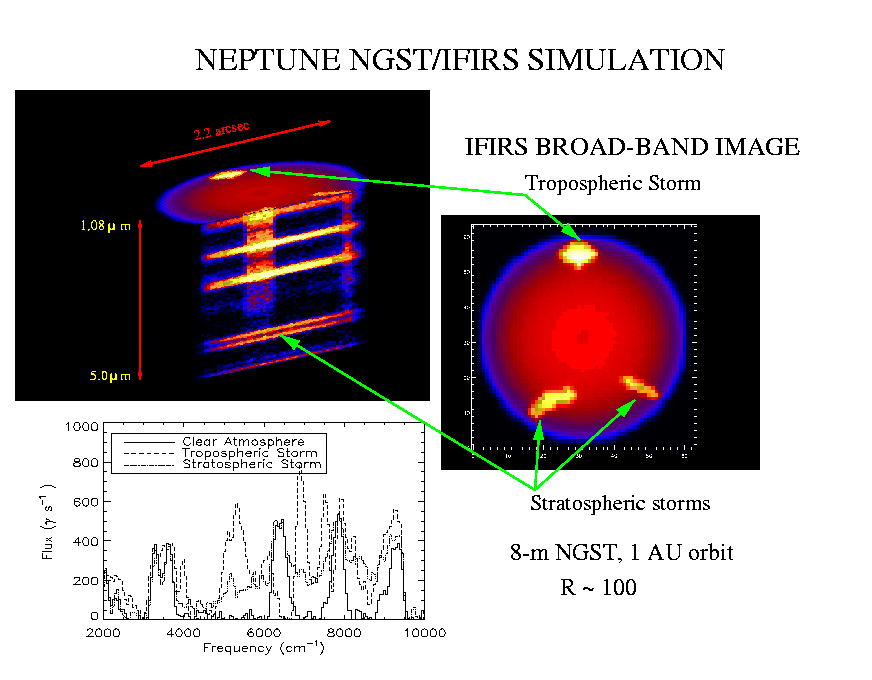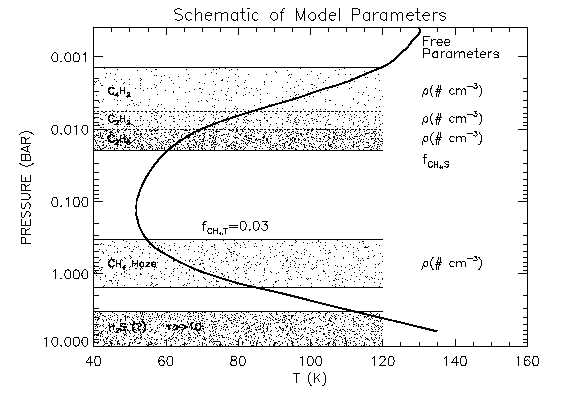

To investigate the potential of an imaging Fourier transform spectrometer for studying the atmospheres of giant planets we have simulated IFIRS observations of Neptune.

This model was generated using the radiative transfer code for Neptune's atmosphere described in Baines & Hammel (1994). The major difference from the earlier code is that methane absorption is represented by correlated-k distribution coefficients. The hazes are parameterized as layers of Mie scatterers with particle size, size distribution, and optical properties constrained by earlier works. The temperature-pressure profile used in the model is that of Lindal 1992, and the stratospheric methane abundance is significantly depleted from that of the troposphere.

The model contains three storm systems, which show up as bright regions
in the broad-band IFIRS image. The Northern storm is in the troposphere,
created by increasing tropospheric haze column density by a factor of 50
from the nominal clear model. The two southern storms are both stratospheric,
with stratospheric haze column densities
30 times nominal.
You can view the individual frequency channels that make up the Neptune data cube.
Click on the image to see a larger version. This data cube contains a low resolution spectum (M =128). Each spectral channel is labeled with the wavenumber in cm-1 at the lower left hand corner. Model data are only available between 2000 and 9250 cm-1 so channels outside this wavelength range are blank.
Credit: The Neptune atmosphere model was produced by H. Roe (UC
Berkeley) using code from K. Baines (JPL).
The first direct evidence for the Kuiper belt was demonstrated 1992 with discovery of a faint 180 km object designated 1992 QB1. Dozens of similar objects, with diameters of up to about 400 km are now known. The Kuiper belt was originally proposed as the reservoir of short-period comets and provides concrete evidence for an ancient era of planet-building. However, on account of their extreme faintness the population and properties of such small trans-Neptunian objects is virtually unknown.
NGST will be able to obtain the first census of Kuiper Belt objects, mapping its population, and dynamical structure. The unparalled sensitivity of NGST will permit deep searches which should yield about photometry for about 4000 new objects. The unparalled sensitivity of NGST will allow detection of 3-5 km sized objects at distances of 30-50 AU and will begin to sample the billions of objects in this regime hinted at by Hubbe Space Telescope observations. Survey fields which sample the 360 degrees of the ecliptic plane at a range of latitudes will permit reconstruction of the three dimensional structure of the Kuiper belt for to validate dynamical simulations of the Belt and the dust disks seen around some young stars. Low resolution IR spectra will be extracted simultaneously for the brightest (K < 27) fifty objects which will be sensitive to surface composition (e.g., water, carbon dioxide, ammonia, and methane) and hence is indicative of collisional history.